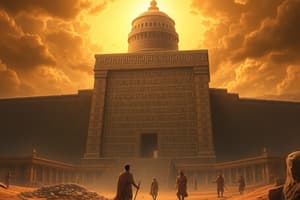Podcast
Questions and Answers
What is Mesopotamia often called due to its historical significance?
What is Mesopotamia often called due to its historical significance?
- The Land Between Rivers
- The Cradle of Civilization (correct)
- The First Empire
- The Ancient Kingdom
Which two rivers formed the boundaries of ancient Mesopotamia?
Which two rivers formed the boundaries of ancient Mesopotamia?
- Nile and Tigris
- Ganges and Euphrates
- Euphrates and Indus
- Tigris and Euphrates (correct)
What was the main purpose of Hammurabi's Code?
What was the main purpose of Hammurabi's Code?
- To track trade routes
- To list military conquests
- To record religious beliefs
- To establish law and order (correct)
What type of writing system did the Mesopotamians develop?
What type of writing system did the Mesopotamians develop?
What was the main economic activity in Mesopotamia?
What was the main economic activity in Mesopotamia?
What major invention helped revolutionize transportation in Mesopotamia?
What major invention helped revolutionize transportation in Mesopotamia?
What role did religion play in Mesopotamian society?
What role did religion play in Mesopotamian society?
What was the primary purpose of temples in Mesopotamian cities?
What was the primary purpose of temples in Mesopotamian cities?
Flashcards
Mesopotamia: The Cradle of Civilization
Mesopotamia: The Cradle of Civilization
A region of ancient Southwest Asia known for its fertile land between the Tigris and Euphrates rivers and considered the birthplace of civilization.
Hammurabi's Code
Hammurabi's Code
A set of laws created by Hammurabi, the Babylonian King, which established rules for governing the society with a focus on justice and order.
Cuneiform
Cuneiform
A cuneiform writing system with wedge-shaped marks pressed onto clay tablets, used for recording information and communication in Mesopotamia.
Rulers and Priests: Power Elite
Rulers and Priests: Power Elite
Signup and view all the flashcards
Agriculture in Mesopotamia
Agriculture in Mesopotamia
Signup and view all the flashcards
Mesopotamian City-States
Mesopotamian City-States
Signup and view all the flashcards
Religion in Mesopotamia: Central to Life
Religion in Mesopotamia: Central to Life
Signup and view all the flashcards
Flooding: Fertile Land
Flooding: Fertile Land
Signup and view all the flashcards
Study Notes
Ancient Mesopotamia Assessment
-
Mesopotamia's Significance: Often called the "Cradle of Civilization" due to historical importance.
-
Defining Rivers: The Tigris and Euphrates rivers defined the boundaries of ancient Mesopotamia.
-
Hammurabi's Code: Its purpose was to establish law and order, not record religious beliefs, track trade routes, or list military conquests.
-
Mesopotamian Writing System: Developed cuneiform, not hieroglyphics, Sanskrit or alphabets.
-
Powerful Social Group: Rulers and priests held the most power in Mesopotamian society, not merchants, farmers, or artisans.
-
Key Economic Activity: Agriculture was the primary economic activity, not mining, fishing or hunting.
-
Mesopotamian Trade Method: Primarily used bartering, not gold coins, paper money or silver pieces.
-
Transportation Revolution: The invention of the wheel revolutionized transportation.
-
Government Type: Mesopotamian cities operated as city-states, not democracies, republics or empires.
-
Religion's Role: Religion played a crucial, not minor, role in daily life in Mesopotamian society.
-
Lowest Social Class: Slaves were at the bottom of the social hierarchy, not farmers, artisans or laborers.
-
Important Crop: Barley was a significant crop, not rice, corn, or potatoes.
-
Number of Hammurabi's Laws: Hammurabi's Code included 282 laws, not 182, 382, or 482.
-
Land Fertility Factor: Regular flooding contributed to fertile land in Mesopotamia, not volcanic ash, forest coverage or mountain runoff.
-
Temple Purpose: Temples served as gathering places and had essential function to societies, not markets or schools.
-
Large Population Support: Food surpluses enabled larger populations to be sustained not military conquests, foreign trade or natural resources.
-
Record Keeper Profession: Scribes, not merchants, priests or farmers, were responsible for maintaining trade records.
-
Hammurabi's Code Principle: The principle of "an eye for an eye" (lex talionis) was a core aspect of the Hammurabi Code, not forgiveness, community service, or monetary fines.
-
Priest Power Maintenance: Religious ceremonies, not military force, wealth or farming, played a critical part in maintaining priest power.
-
Writing Development Purpose: Writing was primarily developed to record trade transactions, not to create stories, artwork or send messages.
Studying That Suits You
Use AI to generate personalized quizzes and flashcards to suit your learning preferences.





